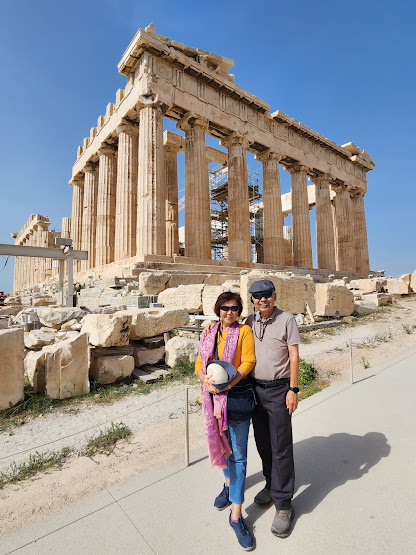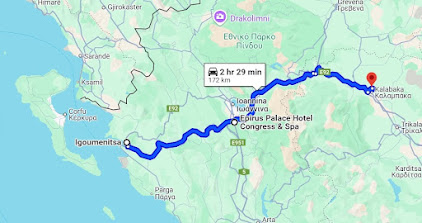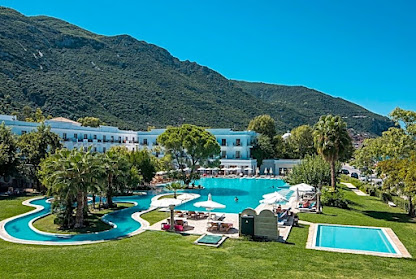After touring Alberobello, we continued on to Bari to catch a ferry to another country - Greece. We had dinner in the ferry before we adjourned to spend the night in the cabin.
 |
| Immediately after checking into the ferry. |
 |
| At the lounge of the ferry the next morning before checking out. |
****************************************************
The next morning, after disembarkation from the ferry berthed at the port of Igoumenitsa, our bus took us to Epirus Palace Hotel for breakfast.
****************************************************
Immediately after breakfast, we moved on from Epirus Palace Hotel in northwest direction for another 100Km to the key attraction of the day - the Monastery of Varlaam in Meteoro.
 |
| Aerial view of the Monastery of Varlaam on Google Map. |
The Monastery of Varlaam, one of the famous "Meteora" monasteries in Greece has a fascinating history rooted in both faith and architectural marvel. Located on top of a massive rock formation in the region of Thessaly, the monastery is part of the Meteora complex, which is now a UNESCO World Heritage Site.
As far back as in the 11th century, hermit monks first began living in the caves of the towering cliffs. These monks sought isolation and a closer connection to God. The steep cliffs provided a perfect retreat. Over the centuries, they began constructing simple dwellings on the rocks, gradually forming small monastic communities.
The monastery of Varlaam was established in the early 14th century. It's named after a monk named Varlaam, who ascended the rock around 1350 and constructed a small church and some monastic cells. Varlaam's initial community was short-lived, as he passed away and his constructions fell into disrepair.
In 1517, Varlaam was revived by two brothers from Ioannina, Theophanes and Nektarios Apsarades. They dedicated themselves to restoring the monastery, building new structures, and establishing it as a religious center. The brothers enlarged Varlaam's church, added monastic cells and built storerooms and a refectory. They constructed a larger main church, dedicated to All Saints, which was completed in 1541.
The above pictures show the many monasteries built on massive rock formations in the vicinity of the Monastery of Varlaam..
***************************************************
The night before our trip to the Monastery, the tour guide kept reminding us the need to dress properly to enter the premise. At the entrance, there is a notice which reads:
"The space is sacred. Please enter dressed modestly. The men with long trousers. The women with long skirts. It is not allowed to enter the Monastery with shorts or backless. Pets are not allowed to enter"
.jpg) |
| Monastery of Varlaam on top of a massive rock formation. |
Left: Current view. Right: Old photo on display showing the hoisting of materials to the the Monastery.
One of the remarkable aspects of Varlaam (and all the Meteora monasteries) is how isolated and difficult they were to access. The builders had to haul materials up the steep cliffs using ladders, baskets and ropes, which made the construction a remarkable feat of engineering and perseverance. Originally, monks used a series of retractable ladders or were lifted up by ropes in nets - a practice that continued for centuries.
Left: Current view. Right: Old photo on display.
C.jpg) |
| Old photos showing monks at work. |
****************************************************
Old timber tank used to store water. Right: Interior of the tank.
****************************************************
In the 20th century, improvements to access (like stairs carved into the rock face) opened the monastery to tourism. Today, Varlaam is a popular destination for visitors who come to admire the architecture, the breathtaking views and the serene environment.
Over time, monastic life dwindled in the Meteora region. According to the local tour guide, there are only eight monks now living at Varlaam.
 |
With Malaysian tour guide, Mee Lee, photo taken on the
staircase leading to the Monastery. |
********************************************
From Meteoro, our bus took us to Mitsis Galini Wellness & Spa Resort, a 5-star deluxe hotel approx. 170Km southeast of Meteoro to spend the night. The hotel is situated in a beachfront at Kamena Vourla, 150Km north of Athens.
.jpg) |
| Champagne for everyone upon arrival at the hotel. |

.jpg)










.jpg)









.jpg)
.jpg)


.jpg)
.jpg)
.jpg)
.jpg)

.jpg)
.jpg)
.jpg)
.jpg)
.jpg)
.jpg)
.jpg)
A.jpg)
B.jpg)
E.jpg)
F.jpg)
C.jpg)
.jpg)
.jpg)








.jpg)


